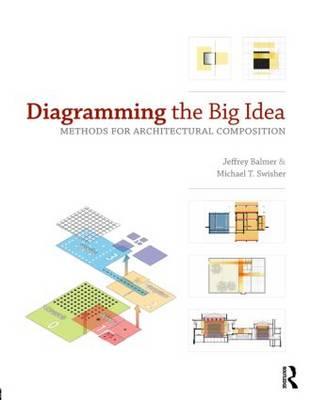Overview
As a beginning design student, you need to learn to think like a designer, to visualize ideas and concepts, as well as objects. In the second edition of Diagramming the Big Idea, Jeffrey Balmer and Michael T. Swisher illustrate how you can create and use diagrams to clarify your understanding of both particular projects and organizing principles and ideas. With accessible, step-by-step exercises that interweave full color diagrams, drawings and virtual models, the authors clearly show you how to compose meaningful and useful diagrams. As you follow the development of the four project groups drawn from the authors' teaching, you will become familiar with architectural composition concepts such as proportion, site, form, hierarchy and spatial construction. In addition, description and demonstration essays extend concepts to show you more examples of the methods used in the projects. Whether preparing for a desk critique, or any time when a fundamental insight can help to resolve a design problem, this new and expanded edition is your essential studio resource.
Full Product Details
Author: Jeffrey Balmer ,
Michael T. Swisher (,both at University of North Carolina at Charlotte, USA)
Publisher: Taylor & Francis Ltd
Imprint: Routledge
Dimensions:
Width: 21.90cm
, Height: 2.30cm
, Length: 27.60cm
Weight: 0.862kg
ISBN: 9780415894098
ISBN 10: 0415894093
Pages: 242
Publication Date: 01 August 2012
Audience:
College/higher education
,
Professional and scholarly
,
Postgraduate, Research & Scholarly
,
Undergraduate
Replaced By: 9781138549906
Format: Paperback
Publisher's Status: Active
Availability: In Print

This item will be ordered in for you from one of our suppliers. Upon receipt, we will promptly dispatch it out to you. For in store availability, please contact us.
Reviews
The book is expansive but deep - indeed, even tenacious - in its treatment of architectural composition. As a result, it is an ideal textbook for students and a perfect resource for enlightened practitioners. - Jim Sullivan, Associate Professor, School of Architecture, Louisiana State University, USA This book offers logical and concise discussions on basic design thinking and provides succinct demonstrations on the fundamentals of diagramming in a manner useful for both students and instructors. Armed with this book as a guide and a reference, beginning design students will have an easier time producing thoughtfully practiced diagrams aimed at clarifying architecture. - William T. Willoughby, Professor of Architecture and Associate Dean, College of Liberal Arts, Louisiana Tech University, USA This book is excellent for students and those interested in composition and architectural design. It allows readers to understand the diagramming process, techniques and their use. The many examples and descriptions in this book provide the foundations for becoming more design oriented while at the same time helping to provide alternate ideas and possibilities for including them into their own designs. The inclusion of a glossary of terms in each section is very helpful for keeping readers on track with the written material and the principles expressed. There is a lot of material to absorb here, and readers will likely find this book acting as a reference because of the wealth of practice and knowledge within it. - Jeff Thurston, Editor, 3D Visualization World Magazine, Germany This is a charmingly disarming primer on the drawn line. Maybe it's the duplicator machine quality of the photos, its reliance on the orthogonal line, or the way it bursts into primary colour at the end...whatever, you might want this curio lining your bookshelf. - Jan-Carlos Kucharek, RIBA Journal, UK [...] provocative and engaging [...] Balmer and Swisher make a clear case that rigor in conceptual organization, and the resulting spatial order, instantiates buildings that are efficient and evocative-that solve problems while engaging us. This change gets only more urgent as functional demands grow and as our tools to process information become exponentially more powerful. -Thomas Leslie, Pickard Chilton Professor in Architecture, Iowa State University, USA. Journal of Architectural Education.
The book is expansive but deep - indeed, even tenacious - in its treatment of architectural composition. As a result, it is an ideal textbook for students and a perfect resource for enlightened practitioners. Jim Sullivan, associate professor, School of Architecture, Louisiana State University, USA This book offers logical and concise discussions on basic design thinking and provides succinct demonstrations on the fundamentals of diagramming in a manner useful for both students and instructors. Armed with this book as a guide and a reference, beginning design students will have an easier time producing thoughtfully practiced diagrams aimed at clarifying architecture. William T. Willoughby, professor of architecture and associate dean, College of Liberal Arts, Louisiana Tech University, USA
Author Information
Jeffery Balmer is an assistant professor of architecture at the University of North Carolina at Charlotte. Michael T. Swisher is an associate professor of architecture at the University of North Carolina at Charlotte.




